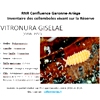 Long considered insects, springtails now form a class in their own right within the sub-phylum of hexapods * (in which insects are dominant) belonging to the phylum of arthropods **. There are around 10 000 species in the world, of which around more than 2200 are present in Europe, and we continue to discover them regularly
Long considered insects, springtails now form a class in their own right within the sub-phylum of hexapods * (in which insects are dominant) belonging to the phylum of arthropods **. There are around 10 000 species in the world, of which around more than 2200 are present in Europe, and we continue to discover them regularly
Springtails classification
Springtails classification
Family determination
 To rough up the identification work, I propose here a visual determination tool which, based on simple questions, makes it possible to establish the membership of a springtail to a given family. Indeed, most of these questions * can be answered on the basis of macro photographs.
To rough up the identification work, I propose here a visual determination tool which, based on simple questions, makes it possible to establish the membership of a springtail to a given family. Indeed, most of these questions * can be answered on the basis of macro photographs.
Families of springtails
 Springtails are classified in about thirty families divided into four orders. There are two morphological types in Springtails , Arthropleones and Symphypléones. Their size varies between 1 and 4 mm on average but can go down to 0.12 mm Sphaeridia pilleata...
Springtails are classified in about thirty families divided into four orders. There are two morphological types in Springtails , Arthropleones and Symphypléones. Their size varies between 1 and 4 mm on average but can go down to 0.12 mm Sphaeridia pilleata...
Collembola species - identification sheets
 I propose here a clickable list of descriptive files established from my photographic inventory of springtails, made specifically on the regional natural reserve "RNR - Confluence Garonne-Ariège" near Toulouse in France as well as on the Occitanie Region.
I propose here a clickable list of descriptive files established from my photographic inventory of springtails, made specifically on the regional natural reserve "RNR - Confluence Garonne-Ariège" near Toulouse in France as well as on the Occitanie Region.
Taxonomy elements
 Before the appearance of genetics, the classification of living organisms was made by bringing together their common characteristics. These similarities made it possible to position them in an order reflecting the position they occupy in the evolution tree. The grouping of common characters is done around an entity
Before the appearance of genetics, the classification of living organisms was made by bringing together their common characteristics. These similarities made it possible to position them in an order reflecting the position they occupy in the evolution tree. The grouping of common characters is done around an entity
Study of springtails DNA barcode
 This article is inspired by the work done by David Porco and Louis Deharveng (National Museum of Natural History) who use the genetic tool and who were kind enough to send me documents relating to their work on springtails. Access to these requires knowledge that the neophyte does not necessarily have, which is why my approach to the object and nature of “barcoding” remains very summary.
This article is inspired by the work done by David Porco and Louis Deharveng (National Museum of Natural History) who use the genetic tool and who were kind enough to send me documents relating to their work on springtails. Access to these requires knowledge that the neophyte does not necessarily have, which is why my approach to the object and nature of “barcoding” remains very summary.